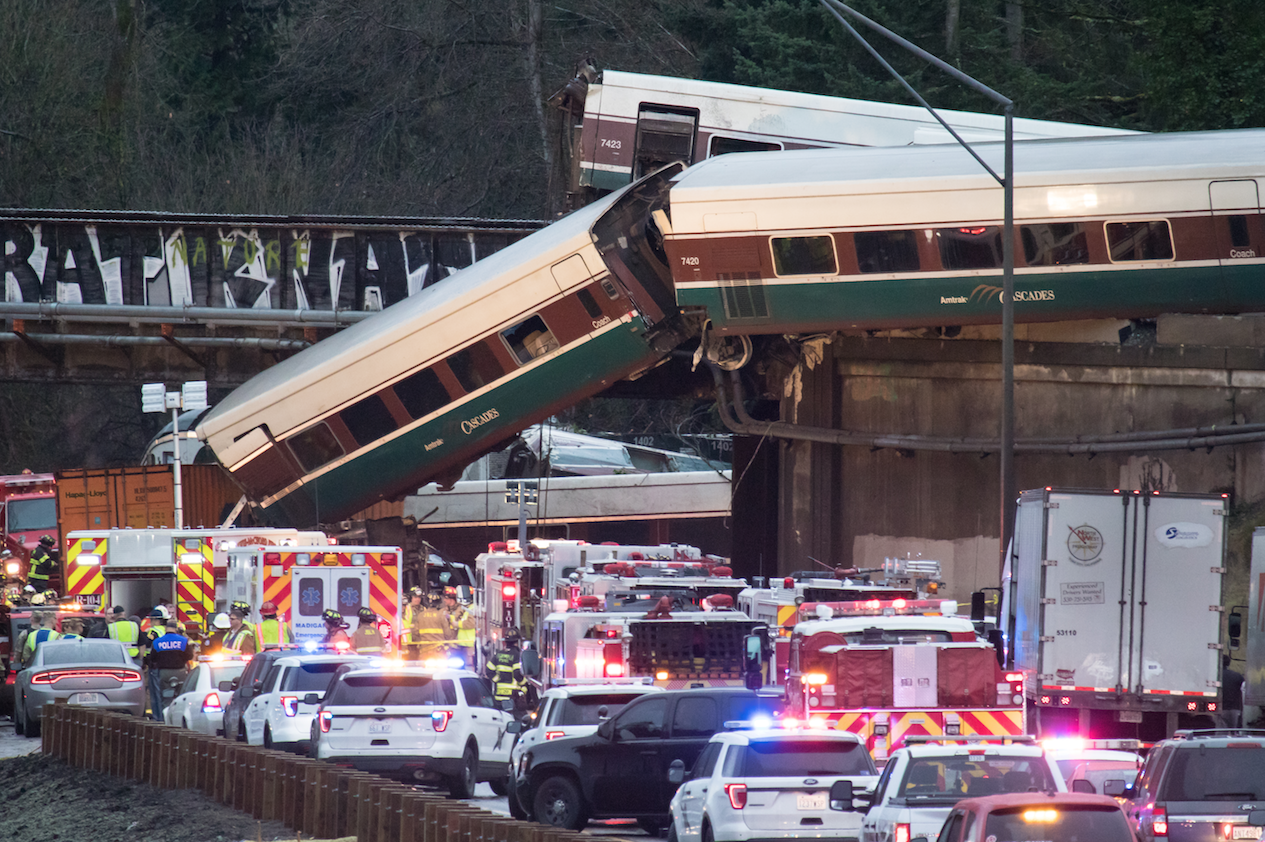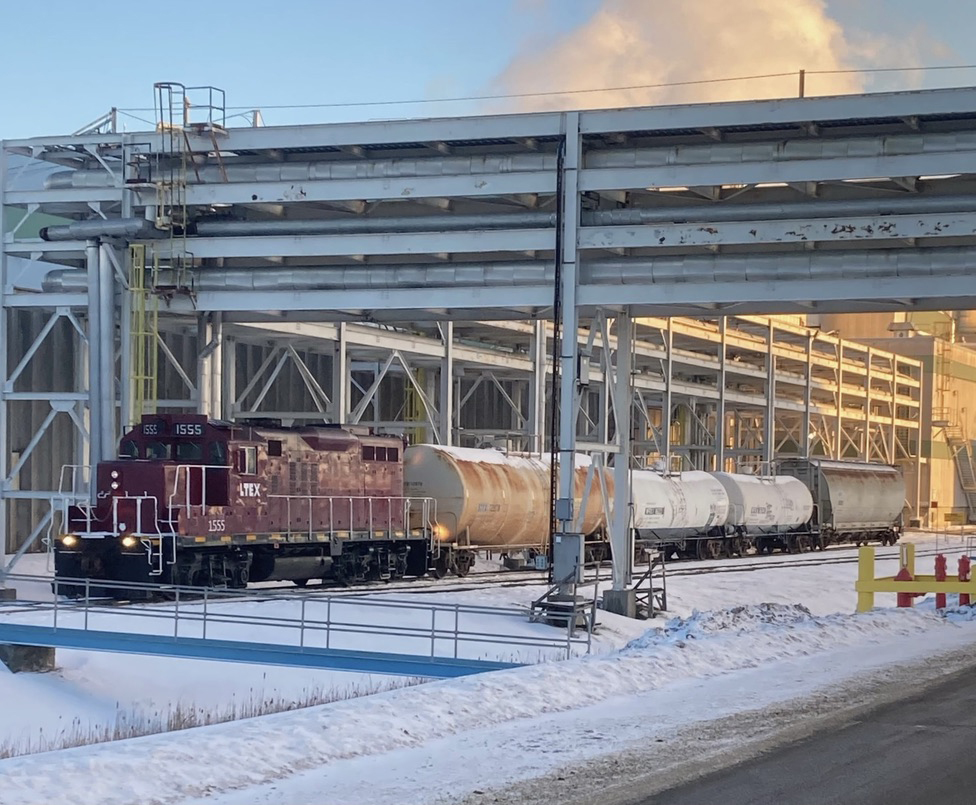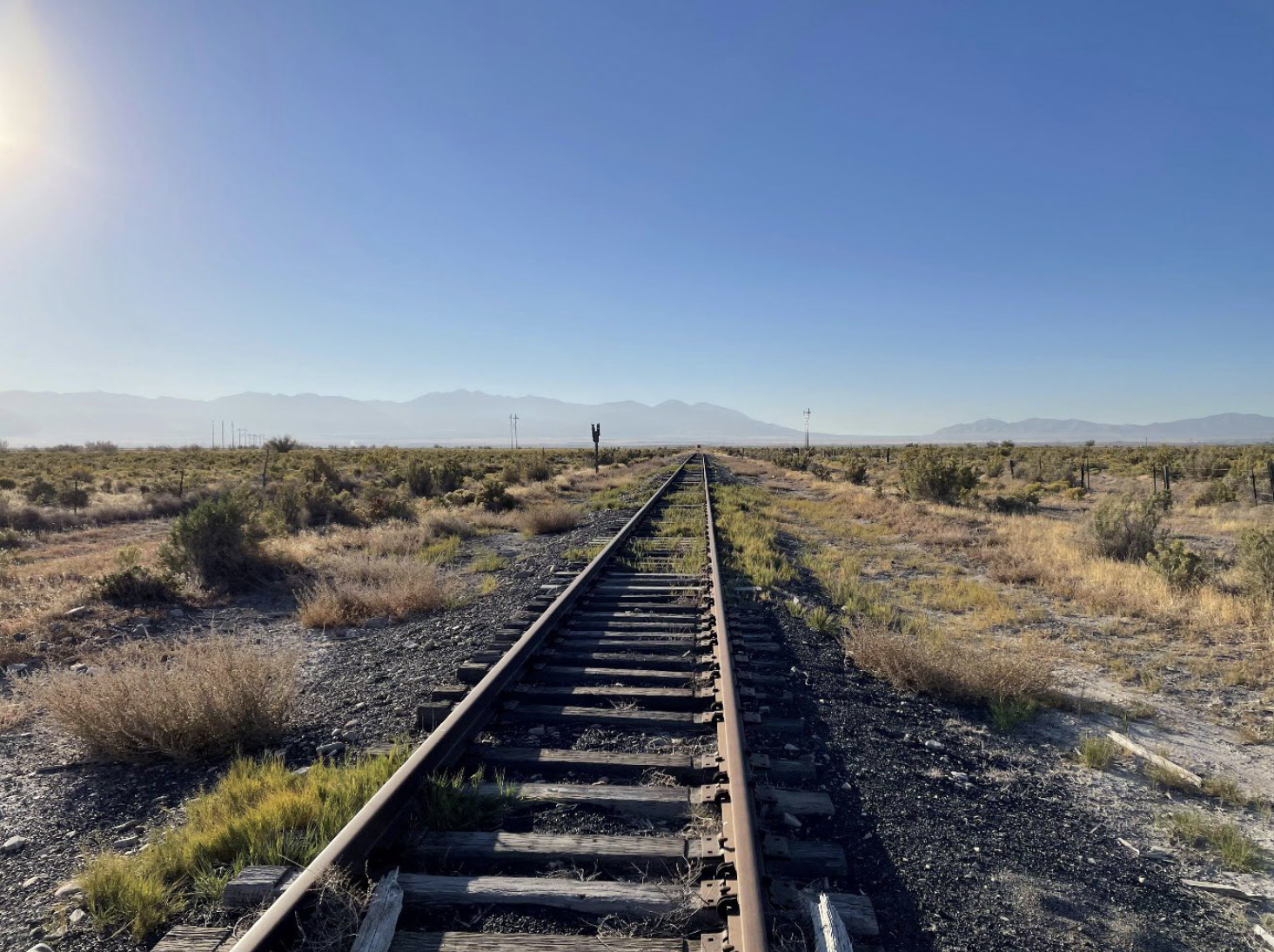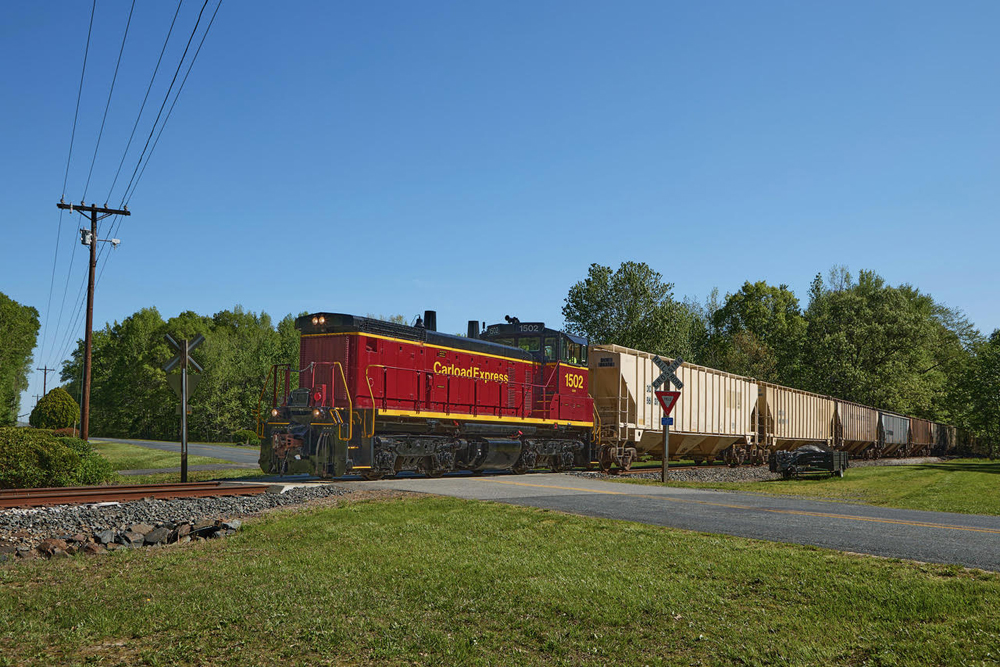
WASHINGTON — A systemic safety failure by state and federal agencies caused the fatal December 2017 derailment of an Amtrak Cascades train on its first run on a new route in Washington state, the National Transportation Safety Board concluded Tuesday.
The derailment investigation revealed a complex set of factors, including the pressure to put the new route in operation, the train crew’s unfamiliarity with the route, the absence of positive train control and the lack of adequate crash protections for the passengers.
The train sped into a 30-mph curve near DuPont, Wash., at 78 mph, on Dec. 18, 2017 and toppled over a bridge onto Interstate 5. Three passengers on the train were killed, and 57 passengers and crew members were injured, as were eight people in their vehicles on the highway.
The absence of positive train control contributed to the crash, the board concluded, as did Amtrak’s over-reliance on its host railroads, in this case Sound Transit, to manage safety risks. Further, the NTSB concluded that conventional passenger rail equipment would have offered better protection for passengers than the Talgo trainset in use.
The engineer and conductor on Train 501 were not familiar with the route, NTSB investigators concluded, and were given few visual aids to help them know the train’s location. The train’s engineer had little experience with the Siemens Charger locomotive he was operating and became confused by an overspeed alarm when it sounded.
“The engineer was set up to fail,” said Chairman Robert Sumwalt. “He was let down.”
The $165 million Point Defiance Bypass, also known as the BNSF Lakewood Subdivision, was supposed to be a signature component of the Obama administration’s $800 million investment in passenger rail improvements in Washington state. The project was part of a larger investment in passenger rail nationwide under the economic stimulus following the 2008 recession.
The funding, provided by the U.S. Department of Transportation and the Washington State Department of Transportation, raised speeds and increased capacity on the route to enable faster service and additional trains between Seattle and Portland, Ore.
Amtrak operates four daily Cascades roundtrips between those two cities, and was supposed to increase them to six. Amtrak has not operated any Cascades trains on the Port Defiance Bypass since the derailment.
The new line was supposed to allow Cascades trains to avoid the slower, curvier BNSF Seattle Subdivision, which follows Puget Sound and is busy with freight traffic.
One obstacle the project did not eliminate, however: That troublesome 30-mph curve at Milepost 19.86.
“Remember that curve,” a road foreman told NTSB investigators he said to the train’s engineer before the first southbound Cascades train to use the new route.
But investigators learned that the engineer missed two signs posted within 2 miles of the curve warning him to slow down. The engineer became distracted by the Charger’s overspeed alarm, which did not sound because he was approaching the 30-mph curve, but because he was 3 mph over the 79-mph limit on the track leading to it.
By the time he understood what the alarm meant, he’d lost any chance of reducing the train’s speed enough to prevent the derailment.
“During this period, he rarely looked outside the train,” said Stephen Jenner, an NTSB investigator who specializes in operations and human performance.
Positive train control, which can prevent overspeed situations, was not in operation on the Point Defiance Bypass at the time of the derailment.
Thanks to Congress, U.S. passenger and freight railroads had another full year at the time to implement PTC. The Rail Safety Improvement Act of 2008 originally mandated the safety system by the end of 2015. Railroads pressured lawmakers to extend the deadline, and they did.
But even if PTC been operational on the Point Defiance Bypass, investigators concluded that the Spanish-designed Talgo trainsets did not provide adequate protection to the train’s occupants in such a high-speed derailment.
NTSB investigators concluded that the three fatalities were caused by the train’s wheelsets becoming detached from the train. One set of detached wheels became a projectile that also struck multiple vehicles on the Interstate, causing more injuries.
“Had the rolling assembly not detached, we may not have had fatal injuries,” Sumwalt said.
Amtrak received an exemption from the Federal Railroad Administration nearly two decades ago for the Talgo trainsets. Under that exemption, they did not have to meet the design standards that otherwise apply to passenger rail equipment operating in the United States.
Mike Hiller, the investigator in charge of the Amtrak 501 team, said the FRA’s exemption for the Talgo equipment was “not in the public interest or consistent with railroad safety.”
Investigators concluded that the train’s conductor, who was in the process of qualifying on the new route, was unable to serve as the engineer’s second set of eyes the day of the derailment and help him operate the train safely.
NTSB board member Bruce Landsberg called it “the blind attempting to help the blind.”
A crew resource management system similar to the one embraced by aviation could help prevent a mismatched crew, the board noted.
Amtrak should also not rely on its host carriers to manage safety risks, it concluded.
“Amtrak should have taken a more proactive role,” said Ryan Frigo, an NTSB investigator who focuses on system safety.
Sumwalt said he was pleased that the board’s staff took a “deep dive.”
“That’s how we identify deficiencies that can be corrected,” Sumwalt said.














Thomas Engel, what you describe is not an error with GPS but with the underlying map data. Of course it is just as possible to have errors in the map data of the railroad. But it seems to me those would get discovered and corrected and this is a lower risk than relying on the judgement of the engineer – particularly as happened in this circumstance: an engineer new to the route who was distracted by some damm alarm going off that he couldn’t figure out what it was for because he was new the the engine.
They didn’t see two signs leading to the curve in the darkness of morning. While PTC is the currently safest option for operations, there is a simple and cheaper solution that probably would have caught their attention. I am seeing more and more road signs illuminated with blinking LED’s along their edges. They get your attention from two or three blocks away. Had those signs incorporated such a simple system, we probably wouldn’t be discussing PTC in the context of that route. But I guess the government and the railroads aren’t looking for simple and economic solutions.
For the Record, PTC has already killed two people, in South Carolina where the regular signals were taken down for installation of PTC. PTC is based on GPS and there are errors in GPS; I live next to one. PTC doesn’t work in yards, hence the Hobolen accident will still happen. Quick! Those with GPS’s! Look at Route I-93 Exit 32 in Mass.: if your GPS shows Washington Ave. as coming into the Route 60 rotary in Medford–it is wrong! As of 2008 many GPS’s showed that error. I do not have confidence in PTC and GPS, especially with all the FRA drum-beating for PTC. Here in Boston on the B&M Southern Div/New Hampshire Route/Lowell Line late evenings I’ve seen a lot of test-trains and real trains being tested on the new signals, the thrid set of signals since I’ve moved her 12 years ago. Lots of running wrong iron, that sort of thing what with commuter trains, an AMTK train, the gravel train, and an occasional freight to play with. The test train even tries the trick of running red signals–I’ve seen it.
Of course weight alone is not the perfect cure to safe design. But the traditional US crash standard, which required the car body to survive essentially 1,000,000 pounds pressure from impact over the draw bar was remarkably strong. By contrast the European standard assumed the vestibule area would compress and the body of the car survive.
In the DuPont tragedy the key to the degree of destruction suffered by the cars seems to have been their separation over the articulated trucks and the failure of their non traditional couplings, which were apparently at least partially some sort of cables.
One feature of US coupling standards is the use of tight lock couplers on mainline passenger equipment intended to operate at higher speeds. These are much less likely to break in a derailment. Train 501 might have better stayed in line if it had not broken apart as it went down the embankment.
A look at the aerial photos at DuPont shows that the train suffered multiple separations. The engine and the front cars went down the embankment in the direction of travel and to the right of the bridges. The fatalities took place in car 7504, which was demolished on that side as it descended. But other cars jumped the railing of the bridge and ended up on the highway to the left and at least one upside down. If the train had remained coupled there is at least a chance cars would not have stacked on each other, nor ended up upside down.
Of course bodies flying around inside would still have sustained severe injuries. But things would have been far more survivable if the detached wheel set had not effectively de-roofed car 7504 and if the side of the car body had remained intact. This does not generally happen to US standard cars.
We can take limited comfort from how many riders did survive the horrible progress of this accident. But we shouldn’t simply dismiss the NTSB’s warnings. And I say this again as someone who long argued US standards were too severe.
No design is perfect against an accident as severe as DuPont. But we need to think very carefully about what happened there and particularly consider its implications for future train-sets.
Are the new Avelia Liberty cars being built for 150mph + speeds on the NEC more likely to survive this sort of crash? They meet our newly revised standards. Should there be some reassessment of these in light of DuPont? Or is there no relevance to the Talgo 6 design and the new US standard? I don’t know the answer to any of this, but think the questions are worth posing.
Of course traditional US cars can be totally compromised in worse case crashes. This befell at least one Amfleet coach that got wrapped around a steel and concrete catenary mast in the Philadelphia NEC derailment. In the Silver Star South Carolina accident an Amfleet II lounge car was bent to a lazy “L” shape. But in that cornfield meet disaster the deaths were all in the Amtrak locomotive cab.
We have traditionally had the highest crash survival car standards in the world. Of course technology evolves, as do safety appliances like PTC.
The Washington tragedy was unambiguously the result of human errors. But we need to honestly assess what role the train’s cars played in the results that befell its riders.
Better training, PTC, better supervision, etc will all probably preclude another derailment at the DuPont curve, but the question of equipment integrity is a very fair issue to discuss and to try within reason to mitigate.
That’s what PTC was mandated for. It was just a year (or so) too late in this case. Sad.
So many sources for this catastrophe. A few observations. I had actually discussed the 30mph curve with my friend Jim Hamre, who died in the crash. Jim had retired from the Washington DOT several years prior and was a highly experienced highway engineer. He explained that the Stimulus Funding that paid for the new route was not sufficient to cover what WashDOT projected could have been what he said could have reached a $60,000,000 total cost to realign not only the curve, but to also rebuild the two bridges over I 5 and to reconfigure the entire approach alignment from the north. Hideous irony? A cost that somehow should have been embraced?
Of course error by the engineer, lack of adequate pre-trip training, failure to have a train-master or other Amtrak supervisor in the cab, grossly excess speed, etc caused the crash. Fate is complex.
But we must not skirt around the catastrophic failure of the Talgo train-set. The wheel-set that essentially ripped asunder the car my friends Jim and Zach were riding in was part of an articulation between cars. It is horrifying to think that this flying truck could essentially de-roof and destroy the side-wall of a entire coach, thus sending the unfortunate riders in its path airborne out of the car to their traumatic fate.
I have long loved the comfort, sophistication, ride and style of the Talgo train-sets, but if the NTSB is right the time is now to retire the three remaining crash-standard wavered sets, and to add the never-used, stored, but fully US compliant Wisconsin sets to the two compliant sets in the northwest equipment pool, modified as needed to add Business Class seating and a nicer cafe.
This would give the Cascades Corridor four usable Talgo train-sets, against a need for five to cover current schedules with a reserve for servicing. Already one Seattle-Vancouver trip is run using a Superliner set. The needed reserve could be met that way, or by allocating the back-up Amfleet set from southern California–or even Horizon fleet from the midwest. More cars will be available fairly soon when the new Siemans fleet is delivered for midwest and California service–thus freeing up Amfleet/Horizon, even ex-NJ Transit upgraded cars. Not ideal, nor as stylish, but safer until Washington and Oregon can somehow find the funds to order new cars. If the current sets are to stay in service they must be strengthened/modified in some way to reduce the chance of anogther Dupont on the countless curves along the Cascades route.
It still boils down to the accident occurred due to the engineer not being aware of where he was. There are mitigating factors contributing to his negligence which is why his legal situation isn’t as bad as the NEC Frankford Junction accident of several years ago where Amtrak’s experienced engineer appears to have “blown” it.
Engineer inattentiveness or disregard for rules has always been a leading cause of railroad accidents since railroads came to America. We now have PTC mandated because of it.
A golf course can be relocated anywhere! Relocating a few holes of it should be no big deal, and surely more important to build a safe railroad without a turn-over speed curve on it than to protect a golf course. Unbelievable to even see any value in the golf course. Bob Crowe belief is weak as even private homes can be relocated with money.
I forgot to mention the assigned Engineer receives an additional payment when he has to use his time conversing with the trainee. That benefit should be removed so the Engineer is more in agreement at which times he feels he can handle a trainee and when he is training himself. This Engineer had only done two qualifying runs on the line, I believe, and not one advance run in darkness as this occurred. Was the cab light on in that dark morning because of the trainee in the cab? If anything, because the assigned Engineer was new to the line, the trainee should have just been assigned to sit in the other seat and watch with no attention given to him by the new assigned Engineer. This repot fails to even name who was actually in the engineer’s seat. Was the trainee in the seat, and where was the assigned Engineer at the time of the wreck?
There should be a new Amtrak rule change which prevents putting a trainee in a cab where the engineer had not had a year experience on that line, and that the placement of the trainee is to the agreement of the operating engineer, without him being paid to post the trainee. It takes a lot of attention of the engineer to post a new trainee on many complex territories.
I hope this was just a preliminary review and there will be a much more comprehensive report to follow. Who was actually running that train?
I am advised elsewhere that the Talgo set damaged at the Steilacoom draw bridge is back in service. This still does not change the reality that only four fully US crash compliant sets exist, if the Wisconsin units are brought to the Cascades route.
Looking at Google Maps the railroad goes under one bridge and then about 1200ft later turns and crosses over I-5. The right of way is squashed between I-5 and a road next to a golf course.
I agree with Doug Potter’s take, although that curve alone in my opinion justifies waiting for the PTC installation, in marked contrast to the rush job that resulted in the (very unacceptable) lack of de rigeur territory familiarity almost every other railroad operation requires.
As for the curve itself, it sounds like money was the obstacle to straightening. It’s not like you couldn’t build a faster reverse curve alignment entirely OVER the I-5 ROW. It’s just that it would be much more expensive. Meanwhile highway ROWs expand as they need. Think for example of the land use impacts and eminent domain takings that must’ve occurred for the TX-130 tollway bypass around Austin compared to the hue and cry over what Texas Central HSR needs in the I-45
corridor.
Anyone can blame no PTC for most non (stupid vehicle) related accidents, that seems some “white collar” excuse here. The train was far over speed. The engineer was in control. I don’t know if signs or signals, were in place or functioning. IF a road goes from 79, to 30, the engineer sure should have been aware or that. I don’t like blaming him (or a her) but someone should have been in control. Rumors of others in the cab, may have contributed, but I can’t see any qualified engineer hitting a sudden 30MPH speed limit, at speed. Aren’t engineers aware of speed limits on they’re route? Did signals, signs of other, change while enroute? Did a “non-engineer” over rule a novice engineer? Still questions here, but no PTC, which “might” have prevented this, is no friggin excuse, for this. Unless the brakes failed, whom ever was controlling the train, failed.
Two additional comments:
At 80 mph few accidents are considered survivable
With as many highly trafficked grade crossings as there are 80 mph strikes me as too fast.
W Cook and Richard Andre,
Forget about looking at Google Earth and seeing if straightening that curve is possible, or look at it and realize that there’s this little road that it passes over called Interstate 5, that Interstate is the reason the curve can’t be straightened out…so that’s’ why the NTSB didn’t look closely at the alignment of the curve as being a contributing factor in the derailment. The reason has been discussed before elsewhere, you’ll have to just take it at face value that the way it is is the way it’s going to stay.
I remain puzzled how an engineer could not remember that about 10 minutes out of Tacoma there is a 30mph curve.
Also I want to add if my facts and memory treat me correctly, this is the former BN/BNSF Lakeville subdivision ex NP, when Sound Transit took it over for their commuter operation, it was renamed the Lakewood Sub, a city south of Tacoma and the terminus of Sound Transit’s south commuter train.
All these reasons but if speed signs would have been seen and obeyed all would have been OK . To many excuses given .
My most recent train ride, earlier this month, was on Metra. This having been the 4th of the month, I came home to Consumer Reports in the mailbox which was an eye opener..
In the train I looked around me. If that train had gone wobbly, or worse, every single passenger would have bounced off six or eight pieces of unpadded metal in every direction. Persons in the upper level (like me) could have been flung in any direction other than a safe direction. Also the seats (if you call them that) provide no support.
In contrast in a car I’m in a seat belt with padded soft surfaces all around and airbags at every seat. Every seat has a head rest whereas Metra has none. For infants and toddlers in automobiles. Consumer Reports evaluates the child seat latches, the worst of which are better than a train which has no child seat latch at all.
Even all that’s good in automobiles isn’t good enough, with more attention now being paid to safety in the rear seats, according to Consumer Reports.
I did as you suggested. Looks to me like there is plenty of room to ease that S curve by simply straightening the track over the highway. It wouldn’t infringe on any adjacent properties outside of the existing ROW.
I was on that I’ll fated train and feel very lucky to be alive and did not get more seriously injured. I still think about that morning every day. Lots of blame to go around.
Those were older Talgo Series VI cars. Two entirely new Series VIII trains sit unused at Beech Grove. I think Amtrak should seriously think about replacing a couple of the older ones.
Also, still not convinced that a train with an engine at the back (even though this was not a true push/pull situation) doesn’t help but actually contributes to the destruction of the lighter cars in front of it.
“During this period, he rarely looked outside the train,” said Stephen Jenner, an NTSB investigator who specializes in operations and human performance. WHY was this not a contributing facture in the above report. Because I think the NTSB is protecting Amtrak who assigned a trainee Engineman when the assigned Engineer had not been fully familiar himself on the route. The Road Foreman of engines should have prevented that assignment and the assigned Engineer should have refuse to make the run with a trainee on that trip. The Engineer has the right to refuse a trainee if he feel it would be a distraction.
This report above did not say how much conversation was taking place between the Engineer and the trainee. Lots of things missing in this rotten result of the study. As about as bad as Canadian SB. I was trained by the Pennsylvania Railroad Engineer Department and then some.
Mr Cook, This was not a new line, it was an existing freight line. I invite you to look at this site on Google Earth and tell me were they would have put the 45 degree curves you have been talking about. I don’t think the residents would give up their golf course for this, Again, please look at Google Earth and tell us your solution.
Sounds like the same ego driven swiss cheese that caused the Challenger to blow up.
– Where were the locomotive unions? Don’t they make sure only the qualified serve behind the controls?
– If Talgo was nearly gone in the US, they are pretty much toast now. That exemption was a killer
– The decision makers at WSDOT that green lighted the train w/o PTC should be terminated
– Sound Transit doesn’t have a solid safety culture, if they did, the train would have never left the station
Hopefully a very hard lesson for those who were more interested in making a statement, than running safe passenger rail
And reading this report it looks like the NTSB never considered that the new line should never have contained that 30 MPH curve at end of a 79 MPH line. The line should have curve right on a 45 MPH curve and then left into another 45 MPH curve widened from the 30 MPH restricted curve. The 45 MPH curves would not be a turnover speed even hit at 82 MPH. The idea on the line was speed. Buy more real estate.
Are there no RR engineer design people within the NTSB to miss such a critical point of a crash study?